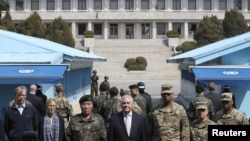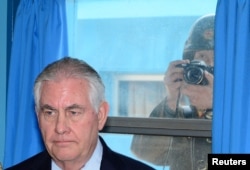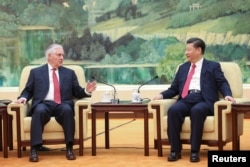Despite U.S. President Donald Trump’s strong rhetoric about restraining the North Korean nuclear threat, U.S. policy options seem to be essentially the same as they were under former President Obama’s Strategic Patience strategy.
Under former President Barack Obama’s Strategic Patience policy, the U.S. refused to engage with the Kim Jong Un regime until it committed to end its nuclear program, while also responding to provocations with increasing military deterrence, economic sanctions and diplomatic isolation.
“I think there are basically three choices. One is to surrender and appease North Korea, just give them everything they want. The second option is preventive war, and the use force to disarm North Korea. And I think the third option, which is the best of the three and the default option, is deterrence and containment,” said Northeast Asia security analyst Daniel Pinkston with Troy University in Seoul.
Strategic patience
The Kim government has reacted with defiance to the U.S. led punitive measures, that include harsh United Nations sanctions, and has openly declared North Korea a nuclear state and accelerated nuclear and ballistic missile tests.
While visiting Seoul last week U.S. Secretary of State Rex Tillerson expressly rejected the Obama Strategic Patience strategy, but also reiterated some of its basic tenets by voicing “unwavering” support for military alliances in South Korea and Japan, and in refusing a Chinese proposal to freeze the North’s current nuclear capability in exchange for halting U.S., South Korea joint military exercises.
“The very premise of the Strategic Patience policy, which is unless the North Korean leadership demonstrates genuine intentions to denuclearization as opposed to a temporary freeze, the United States will not engage in any negotiations with Pyongyang. That premise is still the very foundation of the new policy,” said political analyst Bong Young-shik with the Yonsei University Institute for North Korean Studies.
Even though Tillerson did not rule out taking military action against an imminent North Korean attack or an existential threat posed by an advanced weapon, he stressed that the priority of the Trump administration is much like Obama’s policy; to pressure the Kim government to change course through increased military deterrence and economic sanctions.
ICBM threat
Recent technological advances indicating Pyongyang is moving closer to developing a nuclear-armed intercontinental ballistic missile (ICBM) capable of reaching the U.S. mainland have raised concerns that time is no longer on Washington’s side.
While Tillerson was in Asia, North Korea conducted a more powerful rocket-engine test South Korea’s defense ministry spokesman said showed meaningful progress. But the ministry did not specify if the engine can be used in an ICBM. However, the North's KCNA news agency said on Sunday the engine would help North Korea achieve world-class satellite-launch capability.
Over the weekend President Trump told reporters he held meetings on North Korea at his Florida resort. While he did not refer specifically to the rocket-engine test, he said Kim Jong Un was "acting very, very badly."
China
President Trump has been critical of Beijing for not taking stronger measures to restrain its ally in Pyongyang. China recently halted all coal imports for this year, but has also indicated it is reluctant to implement harsh measures that could trigger widespread instability and the collapse of the Kim government.
But the U.S. secretary of state’s meeting with Chinese President Xi Jinping on Saturday seemed more conciliatory. Xi said afterwards that he appreciated Tillerson’s “comment that the China-U.S. relationship can only be defined by cooperation and friendship.”
To what degree the two world powers are willing to cooperate to resolve the North Korean nuclear threat remains an issue of debate.
Some political analysts like Bong say behind closed doors Tillerson may have suggested a grand bargain, offering China major concessions on long standing issues of contention in exchange for ending the North Korean nuclear threat.
“The list of the conditions that are likely to be proposed by Beijing would include China’s core interests in the South China Sea and no U.S. meddling in any domestic affairs,” said Bong.
There have been rising regional tensions over China’s aggressive moves in the South China Sea, including the building of man made islands for military outposts, and claiming control over contested areas and important international shipping routes.
Angered by criticism
Beijing has also been angered by criticism from the U.S. and the international community over alleged human rights violations concerning the arbitrary arrests of dissidents and censorship.
Other analysts say China is unlikely to take significantly harsher measures against the North in a way that may strengthen the U.S. and South Korean positions in the region, and uncertain whether China has enough leverage to force North Korea to give up its nuclear weapons.
Pinkston said the Trump administration may move to impose unilateral sanctions against more Chinese companies working with North Korea, but that too is something the Obama administration was doing as well.
“Maybe the new administration wants to take greater risks, or try different tactics and methods, to go after those firms and individuals and to put pressure on North Korea, but that is just a tactical implementation and not a change in policy in my view,” he said.












